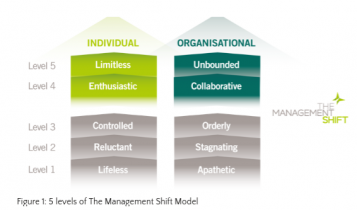There were many headlines recently about the public apology from BrewDog’s CEO for creating a culture of fear. The alleged toxic culture and attitudes towards staff led to a significant number of ex-employees writing an open letter, claiming that many employees have suffered mental illness as a result of working at the company. Sadly, BrewDog’s example is not an isolated incident. Similar headlines far too often appear in media, from stories about French telecom executives who have created a culture of fear that lead to 19 suicides and 12 attempted suicides, to the stories about autocratic leadership in Arcadia group and McKinsey’s opioid scandal.
Brewdog’s public shaming is the most recent example of the consequences of “old style” leadership of putting profit and a “culture of personality” before people, which is no longer acceptable or sustainable. Leaders who value their own voices can lead organisations that make a profit for the short term but to sustain a high performance business in the 21st century, there needs to be more focus on people. This is true particularly in a digital age where discontent and wrongdoing can so easily be called out publicly.
So, what do CEOs need to do to avoid creating these toxic cultures which ruin employees' lives, health, and livelihoods? My research shows that businesses that can clearly articulate their purpose and values and whose leaders demonstrate candour (honest, openness and trust), calmness and compassion will engage the enthusiastic support of their people who will in turn be fully engaged with their customers. I call this humane leadership.
And how can CEOs achieve this? They need to adopt a Level 4 mindset and create Level 4 culture, based on the five levels of The Management Shift Model (figure 1).

This model is based on many years of interdisciplinary research. It shows that there are five levels that our individual mindset goes through and there is a corresponding organisational culture at each level. Every level is characterised by specific thinking patterns, language used, emotions, leadership style and organisational outcomes.
At Level 1, the mindset is “Lifeless” and culture is “Apathetic”. Not much gets done at this level, there is a lot of fear, blame, worry, and this is the place where we can see toxic organisational cultures, such as in the example of a BrewDog. It is not possible to operate at this level for a substantial amount of time. Employees’ physical and mental health is affected, they will leave and eventually the story will leak into the public domain – leading to the situation happening now at BrewDog. And once the reputational damage is done and trust is lost, no amount of public apology can repair it. So, it is very important to prevent creating such a culture in the first place.
At Level 2, the mindset is “Reluctant”, and culture is “Stagnating”. At this level, people do the minimum they can get away with just to get the paycheck. Bosses are un-inspirational, lack drive, and make no effort to inspire good performance.
At Level 3, the mindset is “Orderly” and the culture is “Controlled”. People are micromanaged, they do what they're told to do by their boss. They are led by charismatic leaders who often have a big ego. At that level, we tick the boxes, we achieve KPIs, but we still see low levels of engagement, performance, innovation, and for many organisations low levels of revenues and profit.
To achieve a highly performing organisation, where people are enthusiastic about working for that company, are inspired by their boss, and the organisation does well, employees and organisations need to move to Level 4. At Level 4, the mindset is “Enthusiastic” and culture is “Collaborative”. The keywords at this level are trust, transparency, purpose, collaboration, having fun working, high levels of engagement, high levels of passion for work, focusing on purpose. At that level, there is a step change increase in revenues, innovation, and profit, and it is easy to attract and keep talent. At that level, many of the problems faced by organisations can be eliminated.
We can occasionally reach Level 5 with “Limitless” mindset and “Unbounded” culture. At that level, highly innovative teams work day and night on some amazing innovations for humanity. We cannot operate at this level continuously or we will burn out. The objective is to be anchored at Level 4 and occasionally reach Level 5.
Practical actions that leaders can take to create such highly productive, engaging and humane Level 4 cultures, include, creating open two-way communication where people's voices can be heard, rather than just using top down communication. This was demonstrated clearly at BrewDog where employees felt they had to come together anonymously and write an open letter to be heard. When leaders create a culture that has psychological safety, trust, openness and transparency, people will feel safe to speak up and express their concerns.
Regular anonymous surveys are a useful tool to see how people feel about how things are going, and to elicit some specific suggestions for actions that can be taken to improve the working environment and culture. When people feel that their voice is heard, and the action is taken based on their suggestions, they will become more engaged and productive.
Leaders need to work on their authenticity as well, walk the talk, keep their promises, and take action on reasonable feedback. When they keep their promises, they will develop trust. When they develop trust, there will be more psychological safety, that will allow people to speak up in a productive way. Then actions are taken to improve working conditions, and this creates an upward spiral that will lead to the creation of humane, high performing cultures.
My research over many years shows that businesses that can clearly articulate their purpose and values, whose leaders demonstrate candour and honesty, open communication and trust, as well as calmness and compassion, will engage the enthusiastic support of their people who will in turn be fully engaged with their customers. The culture of humane leadership means employees at the front line are enthused and confident their suggestions for better customer service, new products, new markets, etc, will be listened to. Humane leadership will offer a new competitive advantage, while leaders operating using transactional authoritative leadership working from levels 1, 2 or 3 will become obsolete at best, or will be publicly shamed as BrewDog at worst.
Everyone has a choice, and it is now time to make the right choices and create humane organisations that will be a force for good for the society. That will be the driving force for prosperity in the new world that is now emerging.
Vlatka Ariaana Hlupic is a Professor of Leadership and Management at Hult Ashridge Executive Education, Hult International Business School. She is the founder and CEO of the training, coaching and consultancy firm Management Shift Solutions Limited as well as the author of The Management Shift and Humane Capital.











